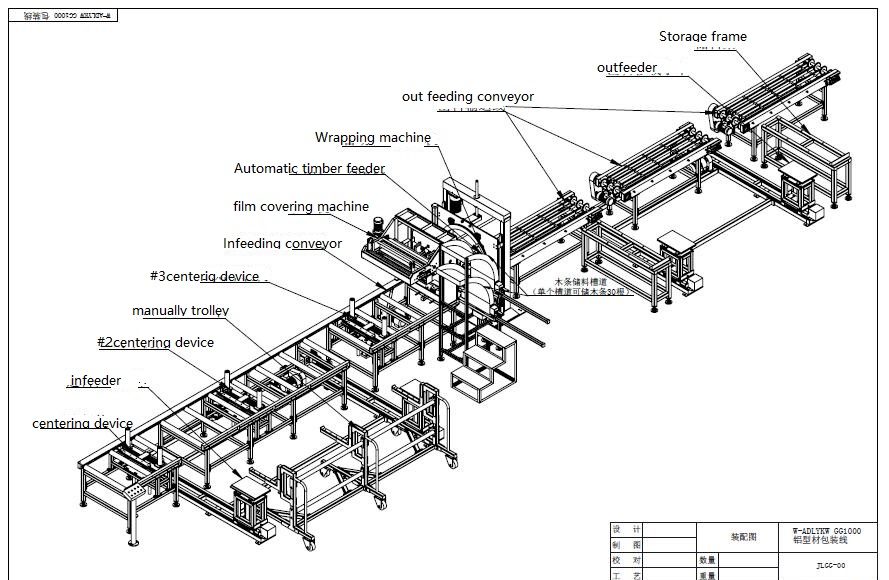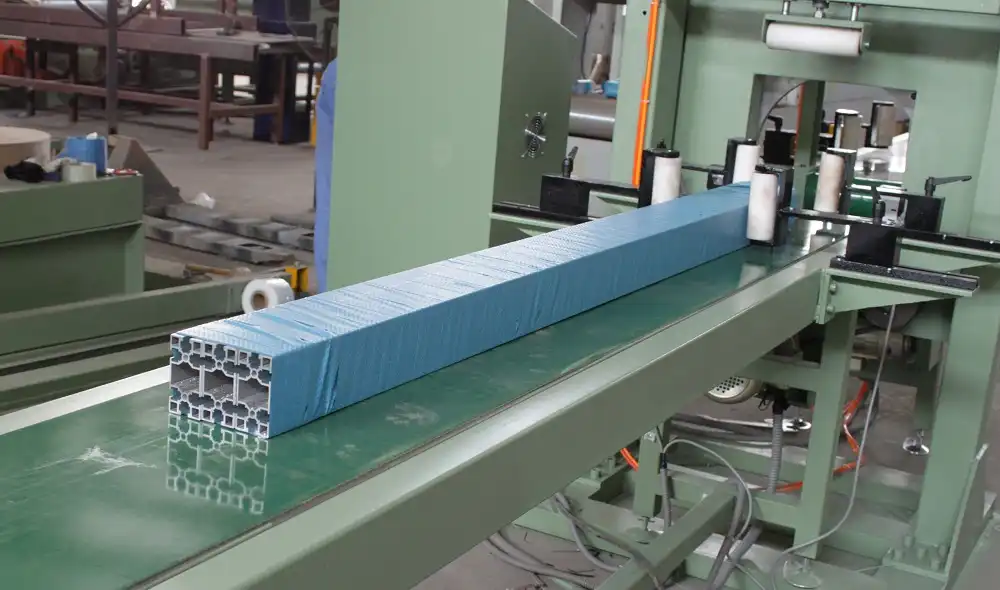Optimizing Aluminum Profile Packaging: A Guide to Automated Bundle Wrapping with Timber Spacers
Efficiently packing long aluminum profiles, especially when bundled with timber spacers for protection and stacking, presents unique challenges in manufacturing and distribution. Manual processes can be slow, inconsistent, and labor-intensive. Automated solutions like the Aluminum Profile Bundle Packing Machine offer significant improvements in speed, consistency, and protection.
This guide explores the features and benefits of using an automated packing line specifically designed for aluminum profile bundles incorporating timber spacers.
Understanding the Automated Packing Process
The aluminum profile packing machine streamlines the entire packaging workflow. A typical automated line includes several integrated stages:
- Infeed Conveyor: Profile bundles are loaded onto the conveyor system, which transports them smoothly into the packing zone.
- Automatic Timber Feeder (Optional Initial): Depending on the configuration, timber spacers might be automatically placed onto the bundle before wrapping.
- Automatic Film Covering/Wrapping Station: The core of the system. The bundle moves into the wrapping ring or tunnel. Wrapping material (like stretch film) is applied securely around the bundle. The machine automatically opens to receive the bundle and closes to perform the wrapping cycle.
- Automatic Timber Feeder (Integrated): Many systems incorporate timber feeding during or immediately before the main wrapping stage, ensuring spacers are correctly positioned and secured within the wrapped bundle. This eliminates the tedious and error-prone manual application of wooden blocks.
- Outfeed Conveyor: The fully wrapped and secured bundle exits the machine, ready for storage or shipment.
This integrated approach allows for continuous, online handling and packing, often manageable by a single operator, significantly boosting throughput.

Key Features and Operational Advantages
Modern aluminum profile packing machines with timber spacing capabilities offer several key advantages:
1. Automated Timber Spacer Handling
- Precision Placement: Automatically positions timber spacers accurately on or between profile layers before or during wrapping.
- Reduced Manual Labor: Eliminates the need for operators to manually insert blocks, saving time and reducing ergonomic strain.
- Improved Consistency: Ensures spacers are placed uniformly on every bundle, enhancing load stability and protection.
2. Robust and Compact Design
- Durability: The machine's frame and mechanical components (gears, chains, motors) are engineered for industrial environments and the forces involved in handling potentially heavy profile bundles.
- Space Efficiency: While robust, designs are often optimized to minimize footprint on the factory floor.
3. Fully Automatic Operation
- Seamless Workflow: The machine automatically handles bundle feeding (via conveyors), opening/closing of the wrapping ring, material application, clamping, cutting, and sealing.
- Continuous Processing: Minimal need for manual intervention allows for uninterrupted packing cycles.
4. High-Speed Performance
- Efficient Material Feed: Systems often use a series of rollers to ensure smooth and rapid delivery of the wrapping material.
- Optimized Cycle Times: The combination of automation and efficient mechanics leads to rapid processing of bundles, increasing overall throughput.

aluminum packaging by paper & by hdpe 5. Versatile Bundle Handling
- Size Accommodation: Designed to handle a wide range of aluminum profile lengths, bundle dimensions, and configurations incorporating timber spacers.
- Automatic Adjustment: Sensors and programmable logic controllers (PLCs) often allow the machine to automatically adapt the wrapping parameters to different bundle sizes.
6. Wrapping Material Flexibility
- Multiple Material Options: Compatible with various protective wrapping materials, including:
- Stretch film (most common)
- Shrink film
- Laminated paper
- VCI (Vapor Corrosion Inhibitor) film for enhanced corrosion protection
- Easy Changeover: Designed for relatively quick and straightforward roll changes to switch between material types or replenish supplies.
Benefits of Automated Aluminum Profile Packing
Implementing an automated packing solution like this provides tangible benefits:
- Increased Efficiency: Significantly higher packing speeds compared to manual methods.
- Improved Product Protection: Consistent, tight wrapping secures bundles and protects sensitive aluminum surfaces from scratches, dust, and moisture during handling and transport. Timber spacers prevent direct contact between layers and provide structural support.
- Reduced Labor Costs: Automation minimizes the need for manual labor in the packing process.
- Enhanced Consistency: Ensures every bundle is wrapped to the same standard, improving load integrity and appearance.
- Material Savings: Optimized wrapping cycles can reduce overuse of packaging materials compared to manual application.
In summary, the automated aluminum profile packing machine with timber spacer integration offers a robust, high-speed solution for manufacturers and distributors. Its ability to automatically handle bundles and spacers, combined with flexibility in size and material, delivers significant improvements in efficiency, protection, and operational consistency. Explore various aluminum packing machine options to find the best fit for specific production needs. For detailed specifications on lines incorporating timber feeding, consider reviewing specific aluminum profile packing lines with timber handling.
